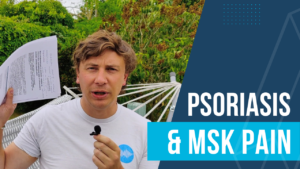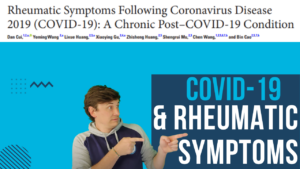Intro
I have had a bit a glut of requests about Polymyalgia Rheumatica (PMR) recently so this blog aims to give an overview of the condition and non-pharmacological management for Physios.
PLEASE REMEMBER – THIS BLOG IS NOT A REPLACEMENT FOR CLINICAL REASONING, IF YOU ARE UNSURE GET ADVICE
Overview
PMR is an inflammatory condition, main symptoms are shoulder and/or pelvic girdle pain and stiffness. The mainstay of treatment is pharmacological usually involving steroids. There has been almost no research into the effectiveness of non-pharmacological interventions2.
Onset is very unlikely prior to the age of 50, peak onset is 65 with women being affected at 3x the likelihood of men. There shouldn’t be any muscle weakness at presentation and likely proximal muscle tenderness to palpation.
Clinical Presentation
Proximal bilateral muscle aching and/or morning stiffness lasting greater than 45 minutes (shoulders 90%) are the most prevalent symptoms. Associated symptoms include general malaise, depression and loss of appetite. A sibling with PMR significantly increases the risk of development of this condition.1
Blood tests should show a raised ESR of >40 and/or a raised CRP. Other bloods will help to exclude differential diagnoses due to the lack of specificity of symptom presentation (more bloods info here).1
There is no role for imaging in suspected PMR.
If PMR is suspected, refer to GP for appropriate management and/or onward referral to Rheumatology.
Physiotherapy Management
As mentioned in the intro there has been no research into the non-pharmacological management of PMR so I have no “evidence base” to present to you for management. The following is based on my clinical experience and adapted from evidence in other conditions.
1
Physiotherapy management should focus on function restoration and general health. Obvious targets include, increased capacity for tasks involving the proximal muscles, cardiovascular health and general health education.
Function Restoration/Maintenance
It sounds obvious to say but this is really going to depend on the function required and the current deficits. Pacing advice is an option if there are no overt physical deficits such as loss of strength or range of motion.
Progressive loading programs will be useful to restore or maintain muscle strength, there is evidence confirming these are safe and effective in many other Inflammatory Conditions so there is nothing to lead me to believe PMR will be different. Be mindful of patients on titrating doses of steroids, I have seen individuals flare up as their dose reduces, ensure they have appropriate options with their exercise programs in case of this outcome.
General exercise programs are important in all inflammatory conditions. All the systemic inflammatory arthropathies (spondyloarthritis, Rheumatoid Arthritis and Psoriatic Arthritis) are associated with an increase in cardiovascular disease risk. The associated benefits of this type of program will help to mitigate some of this risk. Again, the evidence in other inflammatory conditions has shown even high intensity exercise programs to be safe. I advocate these programs to be patient preference led.
Education
Education is massive part of what we do as Physios and for PMR patients this is no different. Knowledge is power as they say and this is part of being able to self-manage any condition.
Condition Education is rather difficult in a condition with such a lack of information regarding pathophysiology but explaining how the inflammatory system is linked to immunity, repair and normal reactions to exercise can help patients to understand why they get the muscle soreness and stiffness associated with PMR. Hopefully this will lead to an understanding that exercise and activities, while not symptomless, are also not harmful to them in the long term. It can also aid in understanding when they have overdone it.
General Health Education includes smoking cessation, dietary advice and of course sleep. All three of these components are associated with outcomes in ALL long-term conditions as well as specifically inflammatory ones.
Closing
Hopefully this blog has given you some insight into recognising PMR if it presents in clinic (think Female, 50+, bilateral stiffness/pain, raised inflammatory markers) and some ideas on how to manage those already diagnosed.
References
- Book by Drs Al-Sukaini, Azam and Samanta https://www.amazon.co.uk/Rheumatology-clinical-handbook-medical-students/dp/1907904263/ref=sr_1_1?ie=UTF8&qid=1538037053&sr=8-1&keywords=rheumatology+a+clinical+handbook
- Dejaco C, Singh YP, Perel P, et al 2015 Recommendations for the management of polymyalgia rheumatica: a European League Against Rheumatism/American College of Rheumatology collaborative initiative Annals of the Rheumatic Diseases 2015;74:1799-1807.


